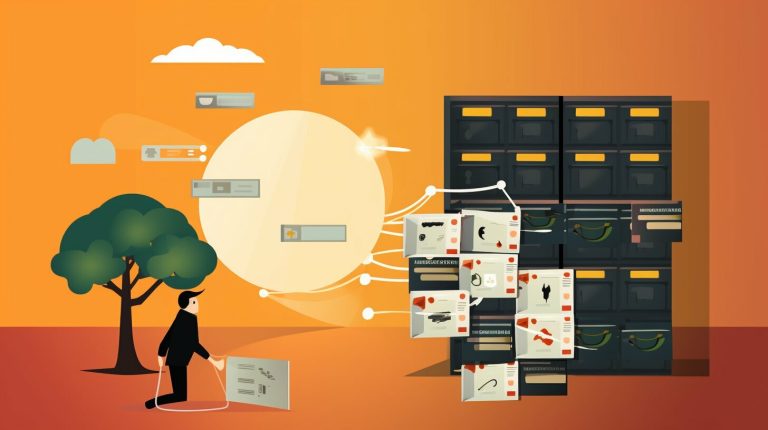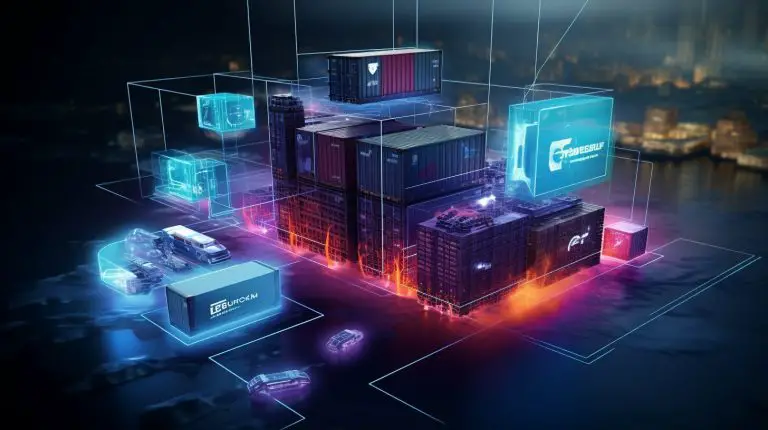Understanding Docker: Breakdown of What it Is and Its Uses.
Docker is an open platform for developing, shipping, and running applications, revolutionizing the way software is created and deployed. It allows you to separate applications from infrastructure, reducing the delay between writing code and running it in production. With Docker, you can containerize your applications, providing lightweight and isolated environments where they can run. These containers contain everything needed to run the application, eliminating the reliance on the host’s installed software.
With Docker, managing the lifecycle of containers becomes seamless. It simplifies the development process by facilitating development, distribution, testing, and deployment. Docker’s tooling and platform enable fast and consistent delivery of applications, making the development lifecycle more streamlined and efficient. Responsive deployment and scaling are made possible, ensuring the smooth operation of your applications.
One of the key advantages of Docker is its lightweight nature. It offers a cost-effective alternative to virtual machines, allowing you to run more workloads on the same hardware. Docker’s client-server architecture ensures effective communication between the Docker client and the Docker daemon, which manages the containers. Docker registries store Docker images, while Docker objects encompass both images and containers.
Portability is another significant aspect of Docker. Docker containers are portable and can run on any machine with a Docker runtime environment. This flexibility allows you to easily move and deploy applications across different environments. Containers are isolated, lightweight, and efficient, providing resource optimization and flexibility in application delivery.
Docker simplifies the deployment and management of applications by packaging them and their dependencies in containers. This makes it easier to deploy and update applications, as you can simply replace or update the containers rather than the entire infrastructure. Docker has had a profound impact on the development community, making containers widely adopted and accessible. It has revolutionized the way applications are developed, tested, and deployed across various industries.
Key Takeaways:
- Docker separates applications from infrastructure, reducing the delay between code writing and production deployment.
- Containers provide lightweight and isolated environments for applications to run, eliminating the need for host dependencies.
- Docker streamlines the development lifecycle, enabling fast and consistent delivery of applications.
- Docker’s lightweight nature offers a cost-effective alternative to virtual machines.
- Containers are portable, allowing applications to run on any machine with a Docker runtime environment.
Docker Containers: Lightweight and Isolated Environments for Applications
Docker uses containers, which are lightweight and isolated environments where applications can run. Containers contain everything needed to run the application, so you don’t need to rely on what’s installed on the host. They are standalone, independent units that encapsulate the application and all its dependencies in a portable and reproducible package.
Containers provide numerous benefits, including improved portability, efficiency, and resource optimization. They are designed to be lightweight, meaning they consume minimal resources and start up quickly. This makes them ideal for running multiple applications on the same host, maximizing hardware utilization.
Furthermore, containers offer isolation, ensuring that each application runs in its own environment without interfering with other applications. This isolation prevents dependencies conflicts and enables greater security, as any vulnerabilities or issues are contained within the container and do not affect the host system.
Docker Container Architecture
| Component | Description |
|---|---|
| Docker Image | A read-only template that defines the application and its dependencies. Images are created from a base image and can be customized using Dockerfiles. |
| Docker Container | An instance of an image that can be run, started, stopped, and deleted. Containers are isolated and encapsulate the entire runtime environment of the application. |
| Docker Registry | A repository for storing and distributing Docker images. Registries can be public or private and provide a central location for sharing and accessing container images. |
In summary, Docker containers offer a lightweight and isolated environment for running applications. They provide portability, efficiency, and resource optimization, making them an ideal choice for modern software development and deployment. By using containers, developers can package their applications with all the required dependencies, ensuring consistency and ease of deployment across different environments.
Docker’s Lifecycle Management: Development, Distribution, Testing, and Deployment
Docker provides tooling and a platform to manage the entire lifecycle of containers, from development to distribution, testing, and deployment. With Docker, developers can efficiently create and package applications along with their dependencies, ensuring consistency across different environments.
During the development phase, Docker enables developers to build and test applications in isolated containers. This allows for easy replication of the production environment and ensures that the application will run seamlessly when deployed. Docker also provides version control and enables collaboration, as developers can share container images and work on the same codebase.
Once the application is ready for distribution, Docker simplifies the process by packaging it into a container. Containers are self-contained units that include not only the application code but also the necessary runtime libraries and dependencies. This encapsulation ensures that the application can run consistently on any machine with a Docker runtime environment.
Testing is a critical part of the software development lifecycle, and Docker streamlines this process by making it easy to create multiple test environments. Developers can quickly spin up containers to simulate various testing scenarios, such as different operating systems or network configurations. This allows for efficient and comprehensive testing, ensuring the stability and functionality of the application.
Finally, Docker facilitates the deployment of applications by providing a platform to manage containers in production environments. Containers can be easily deployed on any infrastructure, whether it’s on-premises, in the cloud, or in a hybrid environment. Docker’s lightweight nature allows for efficient resource utilization, enabling organizations to run more workloads on the same hardware.
Docker Lifecycle Management Process
To better understand Docker’s lifecycle management capabilities, let’s summarize the process:
- Development: Developers use Docker to create and test applications in isolated containers, ensuring consistency and collaboration.
- Distribution: Docker packaging enables easy distribution of applications with all their dependencies, ensuring portability and compatibility across different environments.
- Testing: Docker facilitates the creation of multiple test environments, allowing developers to efficiently test applications in various scenarios.
- Deployment: Docker provides a platform to manage containers in production, allowing for seamless deployment on any infrastructure.
By simplifying and streamlining the software development lifecycle, Docker empowers organizations to deliver applications faster, with improved reliability and scalability.
| Docker Lifecycle Management | Benefits |
|---|---|
| Development | – Consistent development environments – Version control and collaboration – Efficient replication of production environment |
| Distribution | – Portability and compatibility across environments – Easy sharing and deployment of containerized applications |
| Testing | – Reproducible test environments – Efficient and comprehensive testing of different scenarios |
| Deployment | – Seamless deployment on any infrastructure – Efficient resource utilization – Scalability and flexibility |
In conclusion, Docker’s lifecycle management capabilities revolutionize the software creation process. By enabling efficient development, easy distribution, comprehensive testing, and seamless deployment, Docker empowers organizations to build and deliver applications with agility and reliability.
Docker vs Virtual Machines: A Cost-Effective Alternative
Docker offers a cost-effective alternative to traditional virtual machines, enabling efficient resource utilization and increased workload capacity. Unlike virtual machines, which require the allocation of significant system resources to run multiple instances of an operating system, Docker containers provide a lightweight and isolated environment for applications. This allows for greater efficiency in terms of hardware usage, as multiple containers can share the same OS kernel, reducing overhead and optimizing resource allocation.
With Docker, applications are packaged along with their dependencies, eliminating compatibility issues and ensuring consistent performance across different environments. This containerization approach offers a more streamlined and agile deployment process, as containers can be easily created, replicated, and scaled without the need for lengthy setup and configuration. Additionally, Docker’s image-based deployment model allows for faster and more efficient application delivery.
Docker’s ability to maximize hardware utilization also translates into cost savings. By running multiple containers on the same physical machine, businesses can lower their infrastructure costs, reducing the need for additional servers and optimizing their existing resources. Moreover, Docker’s lightweight architecture and quick startup times enable organizations to achieve faster application deployment, minimizing downtime and maximizing productivity.
| Benefits of Docker: | Benefits of Virtual Machines: |
|---|---|
|
|
Docker: A Game-Changer in the Development Community
“Docker has revolutionized the use of containers, making them accessible and widely adopted in the development community.”
Docker’s impact on the development community cannot be understated. The availability of pre-configured and portable containers allows developers to focus on building and improving applications, rather than spending time troubleshooting compatibility issues across different environments. The ability to package applications along with their dependencies simplifies the development workflow, reduces deployment friction, and speeds up the iteration process.
Furthermore, Docker’s popularity has given rise to a vibrant ecosystem of containerized applications and services. Developers can easily access and integrate these solutions into their workflows, further enhancing the productivity and efficiency of their development processes. The versatility of Docker has made it a go-to tool for various use cases, spanning from web development to microservices architecture, and enabling a more agile and scalable approach to software development.
In conclusion, Docker provides a cost-effective alternative to traditional virtual machines, offering a more efficient and scalable solution for application deployment. Its lightweight architecture, streamlined lifecycle management, and broad adoption among developers make it an invaluable tool in the modern software development landscape.
Docker’s Client-Server Architecture and Communication
Docker operates on a client-server architecture, where the Docker client interacts with the Docker daemon to manage containers. This architecture enables the seamless management of containers, allowing developers to easily create, run, and manage applications within isolated environments. The Docker client communicates with the Docker daemon through a REST API, issuing commands and providing instructions for container creation, execution, and termination.
The Docker client can be deployed on the same machine as the Docker daemon or on a remote machine. It simplifies the interaction with Docker by providing a command-line interface (CLI) and a set of easy-to-use commands. These commands allow developers to perform various actions, such as pulling Docker images from registries, creating containers, starting or stopping containers, and monitoring container activities.
Throughout the container management process, Docker uses a range of commands, such as ‘docker pull’, ‘docker run’, ‘docker stop’, and ‘docker rm’, to name a few. These commands form the foundation of Docker’s command-line interface and serve as the building blocks for container orchestration and management tasks.
Below are some commonly used Docker commands:
-
1docker pull
: Retrieves a Docker image from a registry
-
1docker run
: Creates and starts a new container from a Docker image
-
1docker stop
: Halts a running container
-
1docker rm
: Removes a container
-
1docker ps
: Lists the running containers
-
1docker images
: Lists the available Docker images
By leveraging Docker’s client-server architecture and utilizing these powerful commands, developers can efficiently manage containers, streamline the deployment process, and ensure smooth application execution within isolated environments.
| Command | Description | ||
|---|---|---|---|
|
Retrieves a Docker image from a registry | ||
|
Creates and starts a new container from a Docker image | ||
|
Halts a running container | ||
|
Removes a container | ||
|
Lists the running containers | ||
|
Lists the available Docker images |
Docker Registries and Docker Objects
Docker registries are repositories that store Docker images, while Docker objects include images and containers. These components play a crucial role in the Docker ecosystem, enabling the seamless deployment and management of applications.
When it comes to Docker images, registries act as centralized hubs where developers can store and share their pre-built images. These images serve as the building blocks for containers and contain all the necessary dependencies and configuration required to run an application. Docker registries provide a secure and efficient way to distribute these images, allowing developers to pull them as needed for their own projects.
Additionally, Docker objects encompass both images and containers. Images are read-only templates that define the application’s filesystem and runtime environment, while containers are lightweight and isolated instances of these images that can be executed on any machine with a Docker runtime environment. Docker objects offer flexibility and portability, allowing developers to easily package and deploy their applications without worrying about different operating systems or infrastructures.
| Key Points | Summary |
|---|---|
| Docker Registries | Centralized repositories for storing Docker images |
| Docker Images | Pre-built templates containing all dependencies and configurations |
| Docker Containers | Lightweight and isolated instances of Docker images |
| Docker Objects | Encompass both Docker images and containers |
Overall, Docker registries and objects are integral components of the Docker ecosystem, providing developers with the means to easily store, share, and deploy their applications. By leveraging the power of Docker, developers can streamline their software creation process, improve portability, and foster collaboration within the development community.
Portability and Flexibility: Running Docker Containers Anywhere
Docker containers are highly portable and can be run on any machine equipped with a Docker runtime environment. This means that developers can build applications in one environment, package them into containers, and confidently deploy them on different machines without worrying about compatibility issues. Whether it’s a development laptop, a staging server, or a production cluster, Docker containers offer unmatched flexibility.
Benefits of Docker Container Portability
Running Docker containers anywhere brings several benefits to software development and deployment:
- Consistency: Docker containers ensure consistent execution across different environments, eliminating the notorious “it works on my machine” problem. Developers can rest assured that their applications will run the same way in production as they do in their local development setup.
- Ease of Deployment: With Docker, applications and their dependencies are packaged into self-contained containers. This makes deployment a breeze, as containers can be easily transferred from one machine to another, reducing the time and effort required to set up and configure the runtime environment.
- Scalability: Docker’s portability extends to scaling applications. By leveraging container orchestration platforms like Docker Swarm or Kubernetes, developers can effortlessly scale their applications up or down, depending on demand. This flexibility allows for efficient resource utilization without sacrificing performance or availability.
Overall, Docker’s portability and flexibility empower developers to build applications that can be seamlessly deployed and scaled across various environments. This not only saves time and effort but also ensures consistency and reliability throughout the software development and deployment lifecycle.
| Benefits of Docker Portability: |
|---|
| Consistent execution across environments |
| Easy deployment and transfer of containers |
| Efficient scalability with container orchestration |
Simplified Deployment and Management with Docker
Docker simplifies the deployment and management of applications by packaging them and their dependencies in containers. With Docker, you can easily create self-contained environments that include all the necessary components for your application to run. This eliminates the need to rely on the specific configurations of the host machine, ensuring consistency across different environments.
Moreover, Docker provides a streamlined process for deploying and managing applications. By encapsulating applications in containers, you can package them once and deploy them anywhere, making it easy to move applications from development to testing to production environments. This portability not only saves time but also reduces the risk of errors caused by environmental differences.
In addition, Docker offers powerful management capabilities. Through its robust tooling and platform, Docker enables developers and operators to efficiently manage the lifecycle of containers. Whether you’re developing, distributing, testing, or deploying applications, Docker provides a seamless experience and ensures that containers are properly orchestrated and scaled to meet your needs.
| Benefits of Docker for Deployment and Management: |
|---|
| Consistent and Reproducible Environments |
| Isolation and Security |
| Efficient Resource Utilization |
| Faster Development and Deployment Cycles |
| Scalability and Flexibility |
By leveraging Docker’s simplified deployment and management capabilities, organizations can accelerate their software development processes, improve operational efficiency, and deliver applications more rapidly and reliably.
Example Use Case: Microservices Architecture
One example of how Docker simplifies deployment and management is in the context of microservices architecture. In a microservices-based application, various services are broken down into smaller, independent components that communicate with each other to deliver the overall functionality.
Using Docker, each microservice can be encapsulated in a separate container, ensuring isolation and enabling independent scaling and deployment. This allows teams to work on different components simultaneously, reducing the time required for development and testing. Additionally, with Docker’s management capabilities, operators can easily orchestrate and monitor the different containers, ensuring seamless communication and scalability.
Overall, Docker’s simplified deployment and management features make it an essential tool for organizations looking to streamline their software development processes and optimize the efficiency of their deployments.
Docker’s Impact on the Development Community
Docker has had a significant impact on the development community, making containers widely adopted and accessible. The concept of containerization has revolutionized the way developers build, ship, and deploy applications. With Docker, developers can package their applications and dependencies into portable containers, providing a consistent and reliable environment across different machines and operating systems.
The benefits of Docker in the development process are numerous. Firstly, Docker streamlines the development lifecycle by providing a platform to manage containers throughout their lifecycle. This includes development, distribution, testing, and deployment, allowing for faster and more efficient software delivery. With Docker, developers can easily create and share containerized applications, eliminating conflicts between development and production environments.
Another advantage of Docker is its lightweight and efficient architecture. Docker containers are isolated, allowing applications to run with minimal overhead and resource usage. This enables developers to optimize resource utilization and run multiple containers on the same hardware, providing a cost-effective alternative to traditional virtual machines.
Docker Benefits:
- Streamlines development lifecycle
- Enables fast and consistent delivery of applications
- Allows for responsive deployment and scaling
- Provides a lightweight and efficient alternative to virtual machines
- Facilitates resource optimization
The portability and flexibility of Docker containers are also key advantages. Docker containers can run on any machine with a Docker runtime environment, making it easy to deploy applications across different environments and platforms. This eliminates compatibility issues and provides developers with the flexibility to run their applications anywhere.
In conclusion, Docker has transformed the way developers approach application development and deployment. Its impact on the development community is undeniable, with containers becoming the go-to technology for building and shipping applications. With its numerous benefits, Docker has made the software creation process more efficient, scalable, and cost-effective.
| Docker Benefits |
|---|
| Streamlines development lifecycle |
| Enables fast and consistent delivery of applications |
| Allows for responsive deployment and scaling |
| Provides a lightweight and efficient alternative to virtual machines |
| Facilitates resource optimization |
The Speed and Efficiency of Docker
Docker is known for its speed and efficiency, thanks to its lightweight architecture and streamlined processes. By using containers, Docker eliminates the need for running an entire operating system for each application, resulting in faster startup times and reduced resource overhead. Containers are isolated environments that contain all the necessary dependencies for an application to run, allowing for consistent and reliable performance across different environments.
One of the key advantages of Docker’s lightweight architecture is its ability to quickly scale applications. With Docker, you can easily replicate and deploy multiple instances of an application, ensuring high availability and efficient utilization of resources. This enables seamless scaling to handle increased workload demands without incurring excessive costs or performance bottlenecks.
In addition to its speed, Docker also excels in efficiency. Containers offer resource optimization by sharing the host system’s kernel, reducing memory footprint and enabling efficient utilization of CPU resources. Docker’s ability to run multiple containers on a single host makes it a cost-effective alternative to virtual machines, allowing organizations to run more workloads on the same hardware infrastructure.
| Advantages of Docker’s Speed and Efficiency: |
|---|
| Fast startup times |
| Consistent performance across environments |
| Scalability and high availability |
| Efficient utilization of resources |
| Cost-effective alternative to virtual machines |
In summary, Docker’s lightweight architecture and streamlined processes contribute to its reputation for speed and efficiency. By leveraging containers, Docker offers fast startup times, consistent performance, scalability, efficient resource utilization, and cost-effective infrastructure. These advantages make Docker a popular choice for developers and organizations looking to optimize their software development and deployment processes.
Harnessing the Power of Docker: Tutorial and Resources
To harness the power of Docker, follow this step-by-step tutorial for installation and explore additional resources for deeper understanding.
Step 1: Installation
To get started with Docker, you’ll first need to install it on your system. Docker provides installation packages for various operating systems, including Windows, macOS, and Linux. Simply visit the Docker website and download the appropriate package for your system. Once downloaded, follow the installation instructions provided to complete the setup process.
Step 2: Getting Familiar with Docker
Now that Docker is installed, it’s time to familiarize yourself with the basic concepts and commands. Docker provides a comprehensive documentation that covers all the essential topics. Their official documentation is a great resource to explore Docker’s features, architecture, and best practices. You can dive into the documentation at your own pace and refer to it whenever you need guidance or clarification.
Additional Resources:
- Docker Get Started Guide: This step-by-step guide walks you through the basics of Docker, teaching you how to run your first Docker container and build your own images.
- What is a Container?: This detailed article provides a comprehensive explanation of containers, their benefits, and how Docker utilizes them.
Harnessing the power of Docker goes beyond just the installation process. It involves understanding the concepts and best practices, as well as exploring the vast array of resources available. By following the tutorial and leveraging the additional resources mentioned, you’ll be equipped with the knowledge and tools needed to leverage Docker’s capabilities and streamline your software development process.
| Resources | Description |
|---|---|
| Docker Documentation | The official Docker documentation is a comprehensive resource that covers everything from getting started to advanced topics. |
| Docker Community | Join the Docker community to connect with other Docker users, ask questions, and stay up to date with the latest news and releases. |
Exploring Docker’s Use Cases and Benefits
Docker finds application in a wide range of use cases, and its benefits extend to various industries and scenarios. With its lightweight and isolated container environments, Docker offers unparalleled flexibility, scalability, and efficiency in application deployment and management. Let’s explore some of the key areas where Docker shines:
1. Microservices Architecture
Docker is a game-changer when it comes to implementing a microservices architecture. By breaking down an application into smaller, modular services, Docker allows for independent development, testing, and deployment of each service. This approach enables teams to work concurrently, promotes greater code reusability, and makes scaling individual services a breeze. With Docker, it’s easier than ever to build, manage, and scale complex distributed systems.
2. Continuous Integration/Continuous Deployment (CI/CD)
Docker plays a pivotal role in streamlining the CI/CD process. Its containerization capabilities eliminate the need for manual setups and ensure consistency across the development, testing, and production environments. Docker enables automated build, testing, and deployment pipelines, reducing time to market and minimizing the risk of configuration errors. CI/CD workflows powered by Docker allow for efficient collaboration and faster iterations, ultimately accelerating software delivery.
3. Hybrid and Multi-Cloud Deployments
Docker’s portability and compatibility make it an ideal choice for hybrid and multi-cloud deployments. Docker containers can be easily moved and run on different cloud providers, on-premises servers, and even IoT devices. This flexibility enables organizations to avoid vendor lock-in, optimize resource allocation, and achieve high availability across diverse infrastructure setups. Docker’s ability to seamlessly manage workloads across multiple environments simplifies the complexity of modern hybrid cloud architectures.
| Use Case | Benefit |
|---|---|
| Web Application Development | Docker’s agility and reproducibility streamline the development process, allowing for rapid prototyping, efficient collaboration, and seamless integration of third-party services. |
| Data Science and Machine Learning | Docker provides a consistent and reproducible environment for data scientists, enabling easy sharing and reproduction of experiments across different machines or teams. |
| DevOps and Infrastructure Management | Docker simplifies the management and orchestration of infrastructure components, making it easier to scale, monitor, and maintain complex systems. |
As evident from the wide range of use cases, Docker’s benefits are far-reaching. By leveraging containerization technology, organizations can achieve better resource utilization, improve development agility, enhance scalability, and reduce the time-to-market for their applications. Docker’s impact on the development community cannot be overstated, as it has revolutionized the way applications are built, deployed, and managed.
Whether you’re a startup looking to rapidly iterate on your product, an enterprise seeking to optimize resource usage, or a data scientist aiming to share your research effortlessly, Docker provides the tools, platform, and ecosystem to empower your journey.
Conclusion
In conclusion, Docker offers developers an efficient and streamlined platform for developing, shipping, and running applications, bridging the gap between code creation and production deployment. With Docker’s containerization technology, applications can be separated from the underlying infrastructure, reducing the delay between writing code and running it in production.
Docker’s lightweight and isolated containers provide a consistent environment for applications to run, ensuring that they contain everything needed for smooth execution without relying on the host’s installed dependencies. This portability allows Docker containers to run on any machine with a Docker runtime environment, making them flexible and adaptable to various deployment scenarios.
Managing the lifecycle of containers is made easy with Docker’s comprehensive tooling and platform. From development and distribution to testing and deployment, Docker streamlines the entire process, enabling faster and more consistent delivery of applications. This efficiency not only saves time but also allows for responsive scaling and deployment, ensuring that applications can meet changing demands seamlessly.
Furthermore, Docker’s lightweight nature makes it a cost-effective alternative to traditional virtual machines. By running multiple workloads on the same hardware, Docker maximizes resource utilization, leading to improved performance and reduced infrastructure costs.
Thanks to Docker’s client-server architecture, developers have complete control over managing containers using Docker commands. Docker registries store Docker images, while Docker objects encompass both images and containers, providing a structured and organized system to store and retrieve applications and their dependencies.
Overall, Docker has revolutionized the development community by making containers widely adopted and accessible. Its speed, efficiency, and simplicity have made it a preferred choice for developers, empowering them to quickly develop, test, and deploy applications across different industries and use cases.
With its comprehensive tutorial and resources, Docker enables developers to harness its power and unlock the full potential of their applications. By simplifying the deployment and management process, Docker allows developers to focus on their core tasks while ensuring a smooth and reliable application delivery.
In summary, Docker’s impact on the software development landscape cannot be overstated. Its ability to reduce complexity, improve efficiency, and enable seamless application deployment has made it an indispensable tool for developers worldwide.
FAQ
What is Docker?
Docker is an open platform for developing, shipping, and running applications. It allows you to separate applications from infrastructure, reducing the delay between writing code and running it in production.
What are Docker containers?
Docker containers are lightweight and isolated environments where applications can run. They contain everything needed to run the application, so you don’t need to rely on what’s installed on the host.
What is the lifecycle management capability of Docker?
Docker provides tooling and a platform to manage the lifecycle of containers, including development, distribution, testing, and deployment. It streamlines the development lifecycle, enables fast and consistent delivery of applications, and allows for responsive deployment and scaling.
How does Docker compare to virtual machines?
Docker is a cost-effective alternative to virtual machines. It is lightweight, fast, and allows for more workloads to run on the same hardware, providing greater resource optimization.
How does Docker’s client-server architecture work?
Docker uses a client-server architecture, with the Docker client communicating with the Docker daemon to manage containers. The Docker client sends requests to the daemon, which then performs the requested actions.
What are Docker registries and Docker objects?
Docker registries store Docker images, which are pre-packaged applications. Docker objects include both images and containers, allowing for easy distribution, sharing, and deployment of applications.
Can Docker containers run anywhere?
Yes, Docker containers are portable and can run on any machine with a Docker runtime environment. They are isolated, lightweight, and efficient, providing flexibility and easy deployment.
How does Docker simplify deployment and management?
Docker packages an application and its dependencies in a container, making it easy to deploy and manage applications. It streamlines the deployment process and provides streamlined management capabilities.
What impact has Docker had on the development community?
Docker has revolutionized the use of containers, making them widely adopted and accessible in the development community. It has simplified the software creation process and enabled faster application delivery.
What are the advantages of Docker’s speed and efficiency?
Docker is lightweight and efficient, allowing for fast container creation and deployment. Its streamlined processes reduce resource usage and enable faster development and deployment cycles.
Where can I find a Docker tutorial and additional resources?
For a Docker tutorial and further learning resources, you can refer to the official Docker documentation and online tutorials and courses available on platforms like Docker’s website and educational websites.
What are some use cases and benefits of Docker?
Docker has a wide range of use cases, including application development, microservices architecture, continuous integration and deployment, and cloud-based deployments. Its benefits include portability, efficiency, and faster application delivery.
- About the Author
- Latest Posts
Mark is a senior content editor at Text-Center.com and has more than 20 years of experience with linux and windows operating systems. He also writes for Biteno.com






